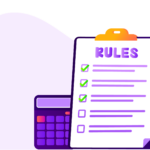Whether you have a 401(k) through your job, a Solo 401(k) or other retirement plan, you must be aware of the rules. The 401(k) in-plan service withdrawal rules are in place to make it hard for one to dip into retirement funds. The IRS wants you to save for retirement, so they create hurdles when trying to withdraw from your accounts. In the following, we discuss the rules for withdrawing 401(k) funds and options you may have.
- You don’t have 100% control of current 401(k) plan funds
- Unless you have a triggering event, you need to satisfy a hardship to withdrew funds
- The 401(k) loan, if available, may be your best option to utilize plan funds
Withdrawing 401(k) Funds
Surprisingly, one doesn’t have 100% control of his or her 401(k) plan funds. Unlike an IRA, you cannot withdraw 401(k) funds whenever you want. If you need money from your IRA, you can pull it out, subject to taxes and an early withdrawal penalty if you are under age 59 1/2.
Unfortunately, unless you meet certain conditions, you cannot access your 401(k) assets at a current employer. If you have funds in an older 401(k) plan, you can do what you want with them. However, so long as you remain with your current employer, you cannot touch those funds unless you satisfy certain conditions.
Plan Triggering Event
The most common way to get your 401(k) funds is when you have a triggering event. In most instances, a triggering event occurs in three ways. First, when you reach the age of 59 1/2, you can start withdrawing funds from the plan (even with a current employer). Secondly, you separate from your job. Obviously, this is not considered an in-plan withdrawal, since you will no longer be working for the company. Lastly, the plan is terminated. If, for some reason, the 401(k) plan is taken away by your employer, you can then move those funds out of the old plan.
401(k) Hardship Withdrawal
A hardship withdrawal occurs when you have “an immediate and heavy financial need.” The plan rules and relevant facts determine if you satisfy this condition. If the below requirements are met, the need will be considered necessary:
- The distribution isn’t greater than the amount of the immediate and heavy financial need, including the amounts necessary to pay any taxes resulting from the distribution.
- The employee has obtained all other currently available distributions (including distribution of ESOP dividends under section 404(k), but not hardship distributions) and nontaxable (at the time of the loan) plan loans, including all other plans maintained by the employer.
- The employee isn’t allowed to make elective deferrals to the plan for at least six months after the hardship distribution.
So long as you meet these criteria, you will be able to take a 401(k) in-plan service withdrawal. The amount that can be withdrawn is limited to the amount that is needed to satisfy the hardship. Basically, you can’t pull out more than you need, just because you want those funds to use elsewhere.
Safe Harbor Distribution
A heavy and financial need is considered satisfied if you meet other certain conditions. These include: medical expenses, certain costs for buying or repairing your primary residence, post-secondary education, preventing eviction or foreclosure, and funeral costs.
Again, you can only withdraw what you actually need. For both safe harbor and hardship distributions, you can only use 401(k) plan funds from elective deferrals, employer profit sharing contributions or matching contributions. You cannot use earnings from the plan.
401(k) Loan
If your plan allows for it, you can borrow from your 401(k) plan. You are limited to $50,000 or 50% of your account balance, whichever is less. You can use those funds tax-free, for whatever reason. The loan, including interest, gets paid back to the plan at least quarterly. If you fail to keep up with payments, the entire balance is treated as a distribution and will be taxable and penalties may be due.
This may be the best option for getting access to your plan funds. Withdrawals are taxable. Loans, on the other hand, are not. Plus, you pay the interest on your loan back to the plan.
IRA Financial president, Adam Bergman, did a podcast about the 401(k) in-plan service withdrawal rules. Check it out below:
Conclusion
Obviously, when you contribute to a 401(k) plan, you are saving for the future. It makes sense that the IRS would limit the availability of those funds. However, if you do need access to those funds, there are ways to take a 401(k) in-plan service withdrawal.
It’s important to keep in mind that dipping into any retirement savings should be a last resort. The more you have in the plan and the longer it’s there, the better off you are in the long run. So long as the funds remain in the plan, they are not taxable. Take advantage of tax deferral and compounding interest for as long as you can. We suggest speaking with a financial advisor before withdrawing funds, as it will affect your finances in the future.







